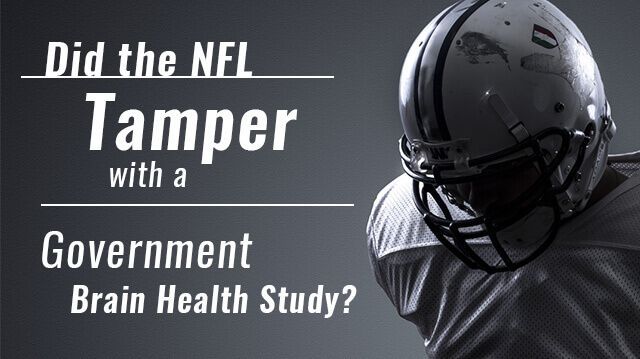
The National Football League has been involved in a complicated dance around the link between brain injury and football for years.In the latest of a string of unsavory decisions, the league has pulled $30 million of funding from the National
Institutes of Health (NIH), the government’s main medical science agency. The money was earmarked for already-approved brain injury research. While grants were made according to specific guidelines, apparently the NFL disagreed with who got funded.
The NIH awarded $16 million of the $30 million promised by the NFL to a research team led by Dr. Robert Stern at Boston University. Stern’s past research found evidence of a link between football and chronic traumatic encephalopathy (CTE), a progressive brain disease associated with brain trauma. He also wrote an affidavit in support of NFL players who opposed an NFL class-action settlement related to brain injury.
A Democratic staff report from the Committee on Energy and Commerce harshly criticizes the NFL for attempting to direct money instead to NFL-friendly researchers. When they were unsuccessful, the report alleges, funding was pulled. The NFL counters that their concerns with Stern’s team were presented through the appropriate channels.
In a telling interaction between the NFL and NIH, the director of the National Institute of Neurological Disorders and Stroke for the NIH was hardly surprised when the NFL expressed concerns with Stern’s team. “Yes, we knew this was coming … Trouble is of course that the [Stern] group is led by people who first broke the science open, and NFL owners and leadership think of them as the creators of the problem.”
The NFL’s accusation that Stern’s team is biased becomes almost comical once in context. The league’s own, now-defunct research team was completely discredited on account of bias and questionable research methods. Moreover, the team second in line for NIH funding consists of researchers affiliated with the NFL’s own Head, Neck and Spine Committee.
NFL in-house concussion committee discredited
The NFL’s first response to new research linking brain disease with football in the 1990s was complete denial. The league sponsored their own research team — the Mild Traumatic Brain Injury Committee — to look into the matter. Their findings, published in a series of peer-reviewed papers, reported little evidence of a link between football and brain injury.
Amid public criticism and a congressional hearing in 2009, the NFL’s concussion committee was disbanded. Chief among complaints was that the doctors on the committee were NFL-employed doctors. They were essentially asked to critique their own work. No wonder, the public surmised, they found little fault.
Recently, The New York Times delved deeper into research led by the NFL Mild Traumatic Brain Injury Committee. In an independent assessment of the data set compiled by the committee they found that roughly 10 percent of players with documented head injuries had not been included. This is a serious omission that clearly impacted study results.
The NFL’s go-to excuse, that players were not reporting injuries, failed to explain the data discrepancy, as cases omitted in the data had been included in team medical records.
Current conflicts of interest
The recently published congressional report is especially critical of Dr. Richard Ellenbogen, co-chair of the league’s Head, Neck and Spine Committee:
“Dr. Ellenbogen is a primary example of the conflicts of interest between his role as a researcher and his role as an NFL adviser,” the study reports. “He had been part of a group that applied for the $16 million grant. After his group was not selected, Dr. Ellenbogen became one of the NFL’s primary advocates in expressing concerns surrounding the process with the BU grant selection.”
Dr. Ellenbogen vehemently denies the allegations: “I never talked to Congress. No one ever asked me my opinion. I had two private conversations with (NIH Director) Walter (Koroshetz), and this is a lesson I guess: Big Government can crush you if you disagree with them.” He maintains that his discussions involving the grant money revolved around the type of research funded, not the grant recipients.
The Head, Neck and Spine Committee is tasked with making football safer for players. Since Ellenbogen’s appointment the committee has developed new protocols for identifying and treating brain injuries on the field and suggested improvements to equipment. Committee members have also been instrumental in advocating for safer procedures in youth sports programs.
Notably, committee members are deemed independent and unpaid.
Does NFL affiliation influence research outcomes?
Though in poor taste, it is neither unusual nor immoral for researchers to fight for funding. Scientific inquiry, unfortunately, is an expensive endeavor. The real question is whether an NFL affiliation taints brain injury research outcomes.
At least one scientist answers a resounding “yes.” Dr. Tom Talavage accepted NFL money in the past, but has since decided to steer clear. His reasoning: “A while back, we talked about all the folks who have ended up on the Head, Neck and Spine Committee, and we think there’s a pretty clear demarcation between the research they did before they were funded by the league or tied to the NFL, and the research they did after they were tied to the league.”
Other researchers note that before NFL interest there was significantly less funding available for traumatic brain injury research. Even if the money is a little tight, they argue, progress is being made. Research that otherwise would not exist is being funded and moving forward.
“As a scientist, when you have an interest in a particular scientific topic, you go to foundations or groups who are interested in giving money to answer that scientific question,” Dr. Jennifer Coughlin, a researcher receiving NFL money told ESPN. “The NIH, until recently, wasn’t advertising … that they’re interested in this topic.”
Notably, the NFL on its own has funded brain injury research to the tune of millions of dollars.
– Erin Wildermuth
Sources:
http://espn.go.com/espn/otl/story/_/id/15667689/congressional-report-finds-nfl-improperly-intervened-brain-research-cost-taxpayers-16-million
https://democratsenergycommerce.house.gov/sites/democrats.energycommerce.house.gov/files/Democratic%20Staff%20Report%20on%20NFL%20NIH%20Investigation%205.23.2016.pdf
http://espn.go.com/espn/otl/story/_/id/14711203/nfl-donations-brain-research-benefit-league-linked-doctors-raise-worries-influence-science-lines
http://www.usatoday.com/story/sports/nfl/2016/05/23/nfl-concussion-congress-nih/84817554
https://www.bostonglobe.com/sports/patriots/2016/05/24/concussion-studies-nfl-protects-product-not-players/sFSHdbge9LT1ZILtCcOMhM/story.html
http://www.nytimes.com/2016/03/25/sports/football/nfl-concussion-research-tobacco.html?_r=0
http://www.pbs.org/wgbh/frontline/article/new-87-deceased-nfl-players-test-positive-for-brain-disease
http://www.nytimes.com/2010/03/17/sports/17concussions.html
http://www.theatlantic.com/entertainment/archive/2013/01/the-nfls-response-to-brain-trauma-a-brief-history/272520
http://operations.nfl.com/football-ops/league-governance/health-safety

